I spent most of my 2 months in Asia in Beijing, so I got to see a fair amount of it by the end of my trip. Because we lived in more the political heart of Beijing, at first I had a hard time with the cold, sterile feel of it that reminded me a lot of Washington, DC. What really warmed me to this city, though, were the hutongs. I kept going back to northern Beijing, where many of the hutongs (back alleys) are, and walking around, from Deshengmen all the way to Yonghegong. While there are hutongs scattered throughout the city, the great thing about this northern part is that, in addition to the residences, there are also lots of shops, eateries, coffeeshops, and bars. The area includes the hip backpacker’s district, Houhai, as well as the hutongs turned cool tourist shopping and eating street known as Nanluguoxiang. And in the midst of all that, plenty of old-world Beijing still exists.
 Hutongs in Beijing (most photos); Adidas & Uniqlo stores at The Village shopping center in Sanlitun; the Great Wall (last)
Hutongs in Beijing (most photos); Adidas & Uniqlo stores at The Village shopping center in Sanlitun; the Great Wall (last)After several weeks in Beijing and plenty of failed attempts in trying to direct cab drivers where we wanted to go, my husband and I finally settled on a fairly reliable method. In addition to writing out (in Chinese) the name and address on paper, we also made sure we had our cell phones and the place’s phone number on us (cheap phones aplenty, so it may be worth it to get one even for a short stay). We learned that it’s pretty common to simply call up the restaurant and ask them to give directions to your driver. This turned out to be the best way to get around. I just remember how even the Beijing natives and longtime drivers would give us this look of defeat whenever we were trying to find some place deep in the hutongs. But having the driver speak directly with the restaurant usually got us there with minimal trouble.
I debated whether to split our Beijing meals into separate posts… But I’m afraid I’d never get through them all that way! Instead, I thought I’d divide them into two categories — the main foods that have come to be associated with Beijing, and the regional and ethnic foods that we tried in the city. Without further ado, here are some of the must-try Beijing foods we ate…
Dumplings. Known as jiaozi when boiled and guotie when fried, dumplings are a food staple of northern China. Of the several dumpling eateries I tried, I liked Bao Yuan Jiaozi Wu (Bao Yuan Dumpling House) the best for its extensive, picture-filled, bilingual menu and, of course, the dumplings themselves. It seems you can get anything wrapped in a dumpling these days, like corn or noodles, but I still like classic fillings like pork and chives. I also became acquainted with lamb dumplings in Beijing, which I love, and at Bao Yuan you can even get multicolored wrappers made with vegetable juices.
Another popular dumpling house is Xian’r Lao Man, which has at least two locations in northern Beijing that I know of. They serve a large variety of dumplings as well as many local homestyle dishes (known as jia chang cai). But it’s best to go here in a group, as they have a minimal order of two liang (a steamerful of 10 dumplings) per type of dumpling, which means it’s hard to try several kinds if you’re only one person. The location I went to (see below) gave me an English menu when I asked — a waitress kindly climbed up a chair to fetch it for me from atop one of their fridges. After I was done, it was tossed back up there! It’s nice to know this is the kind of place that doesn’t have much need for an English menu.
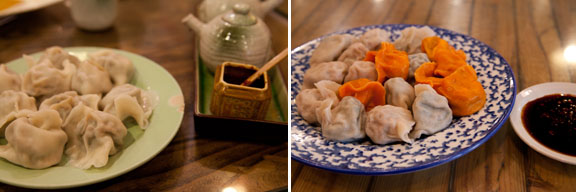 Dumplings at Xian’r Lao Man (left) and Bao Yuan Dumpling House (right).
Dumplings at Xian’r Lao Man (left) and Bao Yuan Dumpling House (right).Besides boiled and fried, there’s the steamed xiaolongbao, the Shanghai soup dumpling, which is in a class all its own. If you’re not familiar with Shanghai soup dumplings, their specialty lies in how the soup is contained inside the dumpling itself, absorbing all the juicy flavors of the filling. I mentioned xiaolongbao in my Shanghai post, but I didn’t get to talk about the legendary Din Tai Fung. That’s because, of all the places we could have eaten at Din Tai Fung — Shanghai, Singapore, Malaysia, even Los Angeles — we decided to do it in Beijing (on my 30th birthday, actually!). And for a chain that started in Taiwan making the soup dumplings that originated near Shanghai, Din Tai Fung may not seem like that obvious of a choice no matter where you decide to try it. But it all makes sense once that delicate dumpling skin breaks and fills your mouth with a rich, gelatinous broth. Din Tai Fung is known for its paper-thin wrappers, each folded with exactly 18 pleats. Every location makes its own broth that results from an intense process of blanching and boiling pigs’ feet and skin to get a clear gelatin that’s wrapped with the filling and melts into a viscous broth when steamed. An article in Afar magazine earlier this year even revealed that the sourdough starter used to make the wrappers is 30 years old!
 Dumplings at the legendary Din Tai Fung, with locations all over the world. Next one opening will be in Seattle!
Dumplings at the legendary Din Tai Fung, with locations all over the world. Next one opening will be in Seattle!Bao Yuan Dumpling House å®æºé¥ºå屋 [map]
æœé˜³åŒºéº¦å店街6å·æ¥¼ä¾§
6 Maizi Dian Jie, Chaoyang District, east of Lufthansa Center/Kempinski Hotel
Phone: 6586-4967
Xian’r Lao Man 馅è€æ»¡ [map]
东城区安定门内大街252å·
252 Andingmennei street, Dongcheng District
Phone: 6404-6944
Din Tai Fung 鼎泰丰 (many locations in Beijing) [map]
æœé˜³åŒºæ–°æºè¥¿é‡Œä¸è¡—24å·
24 Xinyuanxili Zhongjie, Chaoyang District
Phone: 6462-4502
Hot pot (huo guo). Traditional Beijing hot pot (known as shuan rou, or “rinsing meat”) is done with a coal-heated copper vessel, plain water for cooking, and sesame paste for dipping. We met a couple locals who took us out for shuan rou, but unfortunately I no longer remember where. It was just my husband’s kind of place too — no-frills, unpretentious, and full of locals out having a good time. One group next to us was drinking up a storm, toasting in that classic Chinese manner we’d later experience ourselves. (For a shuan rou experience, you might try Savour Asia’s recommendation of Hong Shou Zuan.)
We also tried a swanky hot pot restaurant called Ding Ding Xiang, which was completely not what I expected and turned out to be what one might consider an experience of gaudy luxury in China (but, hey, everyone needs one of those memories, right?). Don’t get me wrong — it was nice, just… not really necessary. And it was rather pricey, too. There were plush, comfy chairs, fake crystal chandeliers, and individual pots of broth. To me, this sort of defeats the whole purpose of huo guo — the communal pot, the sharing, and most of all, the re nao — that Chinese characteristic essential to every successful gathering — fun, din, a certain rowdiness, a bit of happening. But I suppose if you wanted to get dressed up and have hot pot for a special occasion, this would be the place to go.
Somewhere between these two experiences was Haidilao, a popular hot-pot chain among the locals. Both food and service were great here. We had the common Sichuan-style hot pot, with the pot split into a fiery Sichuanese broth on one side and a plain broth with dried dates and goji berries on the other side. I especially loved Haidilao’s dipping sauce bar, with its large variety of sauces, oils, and garnishes. And if you order the noodles here, you’ll get a little noodle-pulling dance performance!
I wish I’d had time to try Little Sheep’s hot pot as well, which is known for broth so good it supposedly makes dipping sauces unnecessary. But since there are Little Sheep restaurants in California, it wasn’t as high on my priority list.
One thing I noticed at all the hot pot places I tried throughout China was that the broth didn’t seem to be the highlight at the end that it’s always been for me when I have hot pot at home, where we start off with plain water and let it gradually absorb all the flavors of the meats and vegetables by the end. At a number of places in China, we watched the waiter start the meal off by emptying a large plastic bag full of multi-colored seasonings straight into the pot — and that was what flavored the broth. It was a little scary! At Haidialao, they gave us a bowl of the broth at the beginning (which was good, but I’m not sure I want to know what’s in it), but besides that, no one was really into drinking the soup at the end. Even for shuan rou, where you start off with plain water, the waiters kept coming and adding more water to our broth as it cooked down, diluting it back to mostly just water.
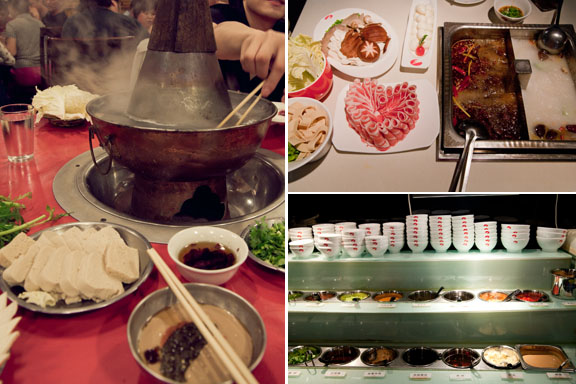 Traditional Beijing-style hotpot or shuan yang rou (left) and hot pot and dipping sauce station at Haidilao (right).
Traditional Beijing-style hotpot or shuan yang rou (left) and hot pot and dipping sauce station at Haidilao (right).Ding Ding Xiang 鼎鼎香
东直门外东ä¸è¡—14å·1层
1/F, 14 Dongzhong Jie, Dongzhimenwai
Phone: 6417-2546
Haidilao Hot Pot 海底æžç«é”…店 (many locations in Beijing)
海淀区海淀区大慧寺路2å·
2 Dahuisi Lu, Haidian District
Phone: 6213-3511
Noodles (mian). I think you could walk into virtually any random noodle place in Beijing and count on having a noodle revelation. For more on noodles, see here and here. I’d definitely recommend trying more rustic, handmade noodles at some hole-in-the-wall, where the strands are uneven and a little ragged but every bit as (if not more) delicious as anywhere else you go. I’d also recommend ordering noodles with your hot pot, where you sometimes get a whole noodle performance that may be worth it alone. And, finally, it’s fun going to a fancier place (fancy in the usual, not over-the-top, sense) like the Noodle Bar, where you can get a front-row seat watching your noodles being made to order. The menu at the Noodle Bar is short, simple, and presented in multiple-choice fashion on a cute little clipboard. I have to admit that I found the thin noodle option a bit too thin (like angel hair) and the thick noodle option a bit too thick (like udon), so I wish there were either a middle option or that the two weren’t such stark contrasts. But both types of noodles we had were wonderfully chewy. And I do admire the simplicity of the restaurant’s concept — pick your noodle thickness and then your beef parts (including tendon, which my husband loves), and these all get served in the same deliciously light and fragrant beef broth. There are also a few tasty side dishes you can order along with the noodles. The restaurant itself is small and intimate — just a kitchen in the center, surrounded by a bar with 12 seats. Hidden away in a courtyard, it’s also very calm and quiet.
 Noodle Bar é¢å§ [map]
Noodle Bar é¢å§ [map]
1949, The Hidden City, Courtyard 4 (behind Pacific Century Place Mall)
æœé˜³åŒºå·¥ä½“北路4å·é™¢
Gong Ti Bei Lu, Chaoyang District
Phone: 6501-1949
Note: By subway, go to the Tuanjiehu stop (on Line 10), which is just southeast of The Village shopping complex in Sanlitun. Exit and head west on Gongtibeiulu, the main street, and you’ll soon come to Pacific Century Place mall. If you take a cab, just ask the driver to take you to Pacific Century Place (盈科ä¸å¿ƒ). Walk through the mall and exit out the back. Across the back driveway you should see the entrance to a courtyard labeled “1949.” Walk through the art galleries until you get inside the courtyard, where you’ll find a number of fancy restaurants, including the Noodle Bar.
Peking duck (kaoya). How could we talk about food in Beijing without talking about the duck! I actually only had Peking duck once the whole time I was there, since there was so much other food we wanted to try. And for our one duck tasting, we decided to go to Da Dong, the fallback place where most tour groups and visitors go. Many reviews I’d read said you would get you the best bang for your buck here, and I think I’d agree. (For more on our adventures at Da Dong, see here.) Unlike dumplings or noodles, where cheaper, grittier places may actually be better, Peking duck needs some proper care and attention in making. So I’d recommend avoiding the “fast-food” type Peking duck joints and heading to either Da Dong or the nicer, pricier places like Quan Jude, which has a long history of making this specialty, or the more modern Made in China or Duck de Chine.
In short, the food at Da Dong was fantastic and the prices were decent, but the service could’ve been better. The restaurant has an extensive menu filled with glamor shots of some of the most beautiful and creative dishes. It’s not indicated on the menu, but they suggested we get a half order of duck, which would serve two and give us room to try a few other items. I picked a few other interesting-sounding dishes — Sichuan-style duck wings (with the meat taken apart and molded into clumps held together by what seemed like gelatin) and this pork dish that we didn’t realize would come with a whole poetry recitation and presentation of falling “snow.” Appropriately, the star of the night was the duck itself — thin, crispy pieces of skin that the waitress taught us to eat dipped in sugar crystals (first time I ate it this way, and it was delicious) and succulent meat. Included with our duck was complementary duck soup, sorbet, and, the finale… grapes presented over dry ice. Yes, this was another one of those over-the-top experiences, but overall, I really wouldn’t mind going back
 Da Dong 大董 (several locations in Beijing) [map]
Da Dong 大董 (several locations in Beijing) [map]
æœé˜³åŒºæ–°æºè¥¿é‡Œä¸è¡—24å·
24 Xinyuanxili Zhongjie, Chaoyang District
Phone: 6462-4502
Street food / snacks (shaochi). Skewered lamb dusted in cumin and chili is one of the things that immediately comes to mind when I think of Beijing. I even brought some packets of cumin and chili back for my sister because she craved it so much. Kebabs in general are enormously popular and can be found all over the streets of the city, but some of the most common spots are Ghost Street and Wangfujing.
Guijie, or Ghost Street, all lit up with red lanterns at night, has a chuan ba (skewer bar) every few steps, and hot pot seems to be popular here too. We went to a place with the hilarious name of Chuan Lai Chuan Qu (roughly, “skewering here and there”). They had a long menu of skewered foods, as well as grilled and stir-fried shellfish and other regular dishes. We tried a hot corn drink here that turned out to be pretty good too. This whole street is lined with restaurants serving tons of kebabs, hot pot, and chili crawfish, all best accompanied by some cold beer.
Wangfujing small eats street is as touristy as touristy gets, but it is fun. It’s also where you can get all kinds of scary-looking things on a skewer, from scorpions to starfish to rodent-like critters. I’m normally a more adventurous eater, but due to past bad experiences in China, I’ve become a little wary of eating strange meats here. So I stuck with things I was a bit more familiar with. Not all the vendors actually season their kebabs at Wangfujing (though some have the seasoning out on a tray that you can dip into), but if you sample widely, you’re likely to find a good one. I also don’t think the kebabs they advertise as “lamb” are actually lamb, but one of our favorite Wangfujing eats is a stall further in on the street that sells a whole grilled leg of lamb — succulent, well seasoned, and nice and lamby. My husband, when asked to name his one favorite meal in China, thinks fondly back on that leg of lamb. I also love the vinegary dan dan noodles just a few stalls down from there.
Incidentally, I would just like to say that chuan (“kebab” or “skewer”) is my favorite Chinese character ever! (See lower left photo in the collage below.)
 Wangfujing small eats street. Note the character for “chuan” (kebab) on the sign in the lower left photo!
Wangfujing small eats street. Note the character for “chuan” (kebab) on the sign in the lower left photo!Jiumen Shaochi is a fun food-court-like place to try all kinds of northern Chinese snacks and street foods. It even has one hallway devoted only to Muslim foods (and you’re asked not to bring any pork through there). What I found most amusing about this place was that, for a moderately sized food court, it had one of the most efficiently run systems I’d seen during all of my time in China: You purchase a card and put money on it, and then each vendor has a machine where they scan the card to deduct payment. You can eat to your stomach’s content and, at the end, get back the remaining change left on your card. Now, the subway in China may run on a similar system, but the efficiency there is all counteracted by the fact that you have to get your bags scanned on the way in. At the food court that is Jiumen, however, hidden in the hutongs of northern Beijing, this electronic payment system makes only for a happy, well-run, self-contained little kingdom.
 Jiumen Shaochi main entrance off Houhai (top left); alley entrance off Gulouxi Dajie (top right); food stalls inside (bottom left); snacks (bottom right).
Jiumen Shaochi main entrance off Houhai (top left); alley entrance off Gulouxi Dajie (top right); food stalls inside (bottom left); snacks (bottom right).Finally, any visitor to Beijing must also try jianbing, the Beijing crepe. It’s smeared with hoisin sauce and chili and topped with an egg, scallions, ham (for 1-2 yuan more), and fried crispies. I wasn’t all that excited about it at first, but it actually turned out to be rather tasty.

Chuan Lai Chuan Qu 串æ¥ä¸²åŽ» [map]
东城区东直们内大街194å·
194 Dongzhimennei Dajie (also known as Guijie, or “Ghost Street”), Dongcheng District
Phone: 6406-7310
Wangfujing Snacks Street 王府井å°åƒè¡— [map]
北京东城区王府井大街277å·
277 Wangfujing Dajie, Dongcheng District
Phone: 6525-1783
Closest subway stop: Wangfujing (Lines 1 and 5)
Jiumen Shaochi ä¹é—¨å°åƒ [map]
北京市西城区åå‹èƒ¡åŒ1å·
1 Xiaoyou Hutong
Phone: 6402-5858
Note: This can be a little hard to find by the hutong address. The main entrance, with plenty of large signage, is off Houhai (“Back Lake”), close to the Former Residence of Soong Ching Ling (a good landmark to go by when asking/giving directions). If coming from Gulouxi Dajie, right around No. 158 you’ll find an alley with small signs marking “Houhai Jiadao” (the alley) and “Jiumen Shaochi.”
Jianbing (Beijing crepe) 煎饼
All over the city! There’s usually a stall right in front of the subway entrances.
Next up, my last China post for now… The great variety of ethnic and regional foods available in the Beijing, including some of my favorite meals from our trip.
Update: Map links added 4/8/13.
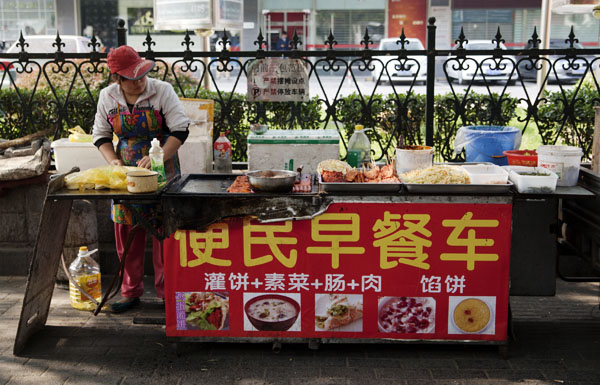

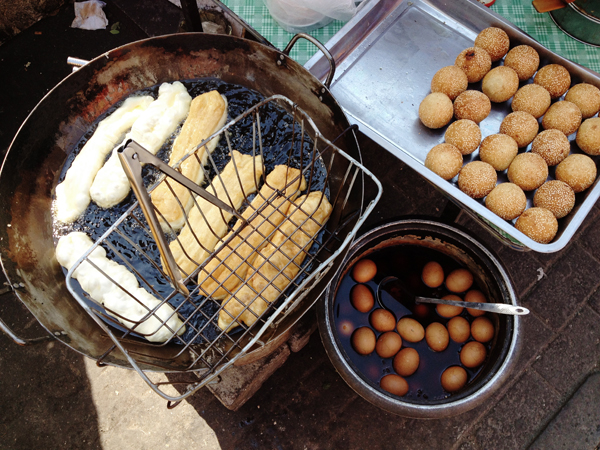
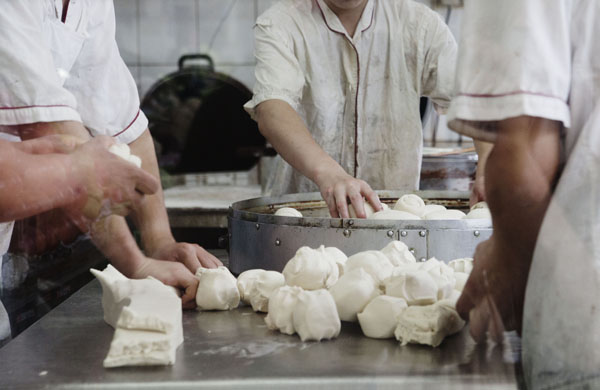
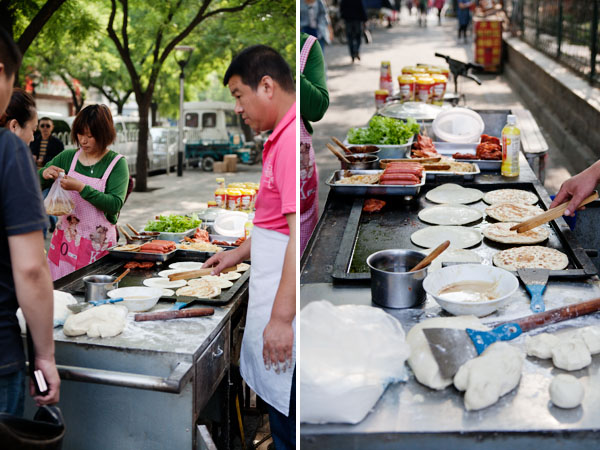 The lard creates a pocket in the center of the pancake that you break open with chopsticks and fill with egg.
The lard creates a pocket in the center of the pancake that you break open with chopsticks and fill with egg.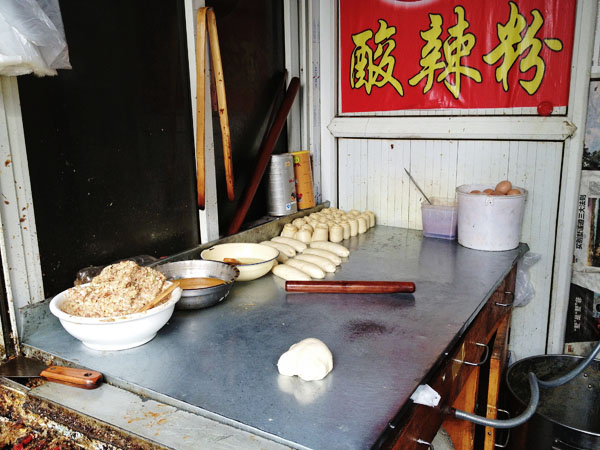














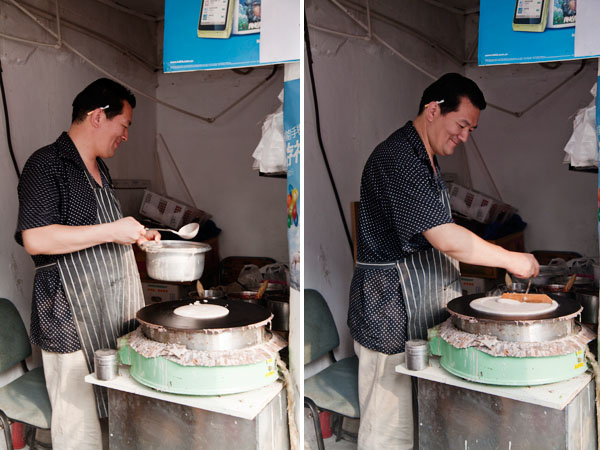
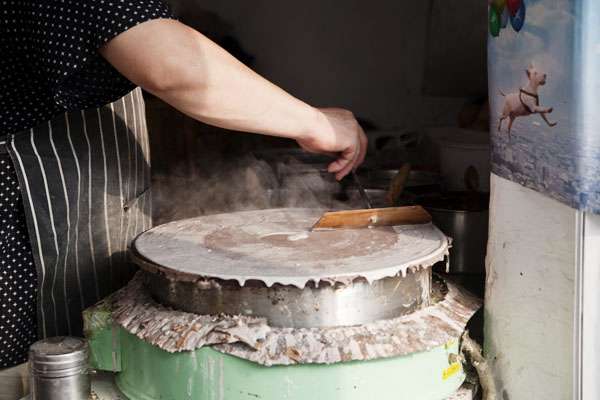






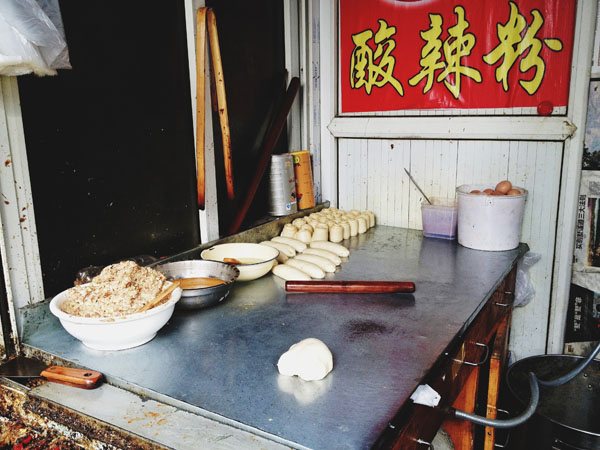






















Connect with us